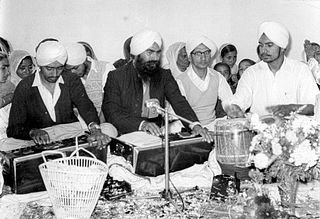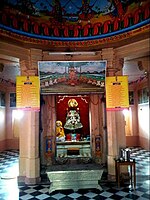
Kabir was a well-known Indian mystic poet and saint. His verses are found in Sikhism's scripture Guru Granth Sahib, the Satguru Granth Sahib of Saint Garib Das, and Kabir Sagar of Dharamdas. Today, Kabir is an important figure in Hinduism, Sikhism and Islam, especially in Sufism.

Avatar is a concept within Hinduism that in Sanskrit literally means 'descent'. It signifies the material appearance or incarnation of a powerful deity, or spirit on Earth. The relative verb to "alight, to make one's appearance" is sometimes used to refer to any guru or revered human being.
Bhakti is a term common in Indian religions which means attachment, fondness for, devotion to, trust, homage, worship, piety, faith, or love. In Indian religions, it may refer to loving devotion for a personal God, a formless ultimate reality or for an enlightened being. Bhakti is often a deeply emotional devotion based on a relationship between a devotee and the object of devotion.

The Bhakti movement was a significant religious movement in medieval Hinduism that sought to bring religious reforms to all strata of society by adopting the method of devotion to achieve salvation. Originating in Tamilakam during 6th century CE, it gained prominence through the poems and teachings of the Vaishnava Alvars and Shaiva Nayanars before spreading northwards. It swept over east and north India from the 15th century onwards, reaching its zenith between the 15th and 17th century CE.
Bhakti yoga, also called Bhakti marga, is a spiritual path or spiritual practice within Hinduism focused on loving devotion towards any personal deity. It is one of the three classical paths in Hinduism which lead to moksha, the other paths being jnana yoga and karma yoga.

The Guru Granth Sahib is the central holy religious scripture of Sikhism, regarded by Sikhs as the final, sovereign and eternal Guru following the lineage of the ten human gurus of the religion. The Adi Granth, its first rendition, was compiled by the fifth guru, Guru Arjan (1564–1606). Its compilation was completed on 29 August 1604 and first installed inside the Golden Temple in Amritsar on 1 September 1604. Baba Buddha was appointed the first Granthi of the Golden Temple. Shortly afterwards Guru Hargobind added Ramkali Ki Vaar. Later, Guru Gobind Singh, the tenth Sikh guru, added hymns of Guru Tegh Bahadur to the Adi Granth and affirmed the text as his successor. This second rendition became known as the Guru Granth Sahib and is also sometimes referred to as the Adi Granth.

Kirtana, also rendered as Kirtan or Keertan, is a Sanskrit word that means "narrating, reciting, telling, describing" of an idea or story, specifically in Indian religions. It also refers to a genre of religious performance arts, connoting a musical form of narration or shared recitation, particularly of spiritual or religious ideas, native to the Indian subcontinent. A person performing kirtan is known as a kirtankara.

Jagadguru Swami Ramananda or Ramanandacharya was an Indian 14th-century Hindu Vaishnava devotional poet saint, who lived in the Gangetic basin of northern India. The Hindu tradition recognizes him as the founder of the Ramanandi Sampradaya, the largest monastic Hindu renunciant community in modern times.

Dhanna Bhagat, also known Dhanna Jaat, Dhanna Jatt, Dhanna Bairagi or Sant Dhanna, was a mystic poet and a Vaishnav devotee whose three hymns are present in Guru Granth Sahib.

A matha, also written as math, muth, mutth, mutt, or mut, is a Sanskrit word that means 'institute or college', and it also refers to a monastery in Hinduism. An alternative term for such a monastery is adheenam. The earliest epigraphical evidence for mathas related to Hindu-temples comes from the 7th to 10th century CE.

Namdev, also transliterated as Nam Dayv, Namdeo, Namadeva, was a Marathi Vaishnava saint from Narsi, Hingoli, Maharashtra, Medieval India within the Varkari tradition of Hinduism. He was as a devotee of the deity Vithoba of Pandharpur.

The Ramanandi, also known as Ramavats, is one of the largest sect of Vaishnavas. Out of 52 gates of Vaishnavism divided into 4 Vaishnava Sampradayas, 36 are held by Ramanandi. The sect mainly emphasizes the worship of Rama, Sita, and Hanuman and avatars of Vishnu. They consider Rama and Sita as Supreme Absolute who are non different from each other. It is considered to have been founded by Ramananda, a 14th-century Vaishnava saint.

The principal Sikh scripture is the Adi Granth, more commonly called the Guru Granth Sahib. The second most important scripture of the Sikhs is the Dasam Granth. Both of these consist of text which was written or authorised by the Sikh Gurus.
Hinduism and Sikhism are Indian religions. Hinduism has pre-historic origins, while Sikhism was founded in the 15th century by Guru Nanak. Both religions share many philosophical concepts such as karma, dharma, mukti, and maya although both religions have different interpretation of some of these concepts.

Bhagat Sain, also known as Sena Bhagat, was a Hindu mystic poet and saint of the Bhakti movement that lived in the end of the fourteenth and the beginning of the fifteenth century. His name was known in every house due to his devotion to god. Bhagat Sain was a barber of the royal court of Raja Ram Singh, ruler of Rewa. He was a disciple of Ramananda.

Trilochan was a celebrated medieval Indian saint and one of devotee whose hymns are present in Guru Granth Sahib, the holy book of Sikhs.

Ravidas or Raidas (1267–1335) was an Indian mystic poet-saint of the Bhakti movement during the 15th to 16th century CE. Venerated as a guru in the modern regions of Uttar Pradesh, Bihar, Rajasthan, Gujarat, Maharashtra, Madhya Pradesh, Punjab, and Haryana, he was a poet, social reformer and spiritual figure.

Gurū Nānak, also known as Bābā Nānak, was the founder of Sikhism and is the first of the ten Sikh Gurus. His birth is celebrated as Guru Nanak Gurpurab on Katak Pooranmashi, i.e. October–November.
Hindu denominations, sampradayas, traditions, movements, and sects are traditions and sub-traditions within Hinduism centered on one or more gods or goddesses, such as Vishnu, Shiva, Shakti and so on. The term sampradaya is used for branches with a particular founder-guru with a particular philosophy.

The Guru Granth Sahib, is the central religious text of Sikhism, considered by Sikhs to be the final sovereign Guru of the religion. It contains 1430 Angs, containing 5,894 hymns of 36 saint mystics which includes Sikh gurus, Bhagats, Bhatts and Gursikhs. It is notable among foundational religious scriptures for including hymns from writers of other religions, namely Hindus and Muslims. It also contains teachings of the Sikh gurus themselves.




















